Are You 21 Or Over?
YesOr
No By clicking yes, you certify that you are over 21 years old. By using this website, you agree to our legal disclaimer.Table of Contents
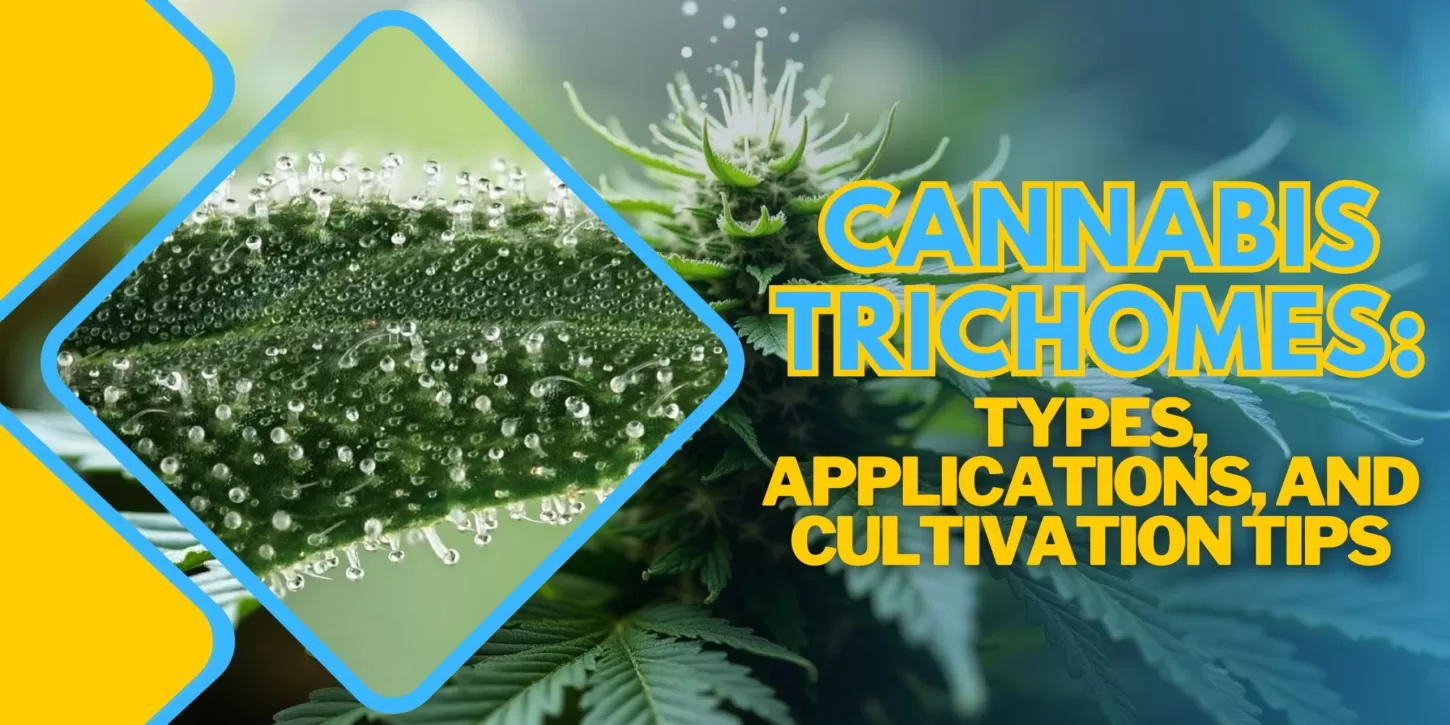
Cannabis trichomes are the microscopic resin factories of the plant that create the cannabinoids, terpenes, and flavonoids. As growers and connoisseurs are concerned about quality, trichome knowledge is the foundation of optimizing growing and harvesting methods. In this post, we dissect all aspects of cannabis trichomes to equip growers with the information necessary to maximize potency, flavor, and yield.
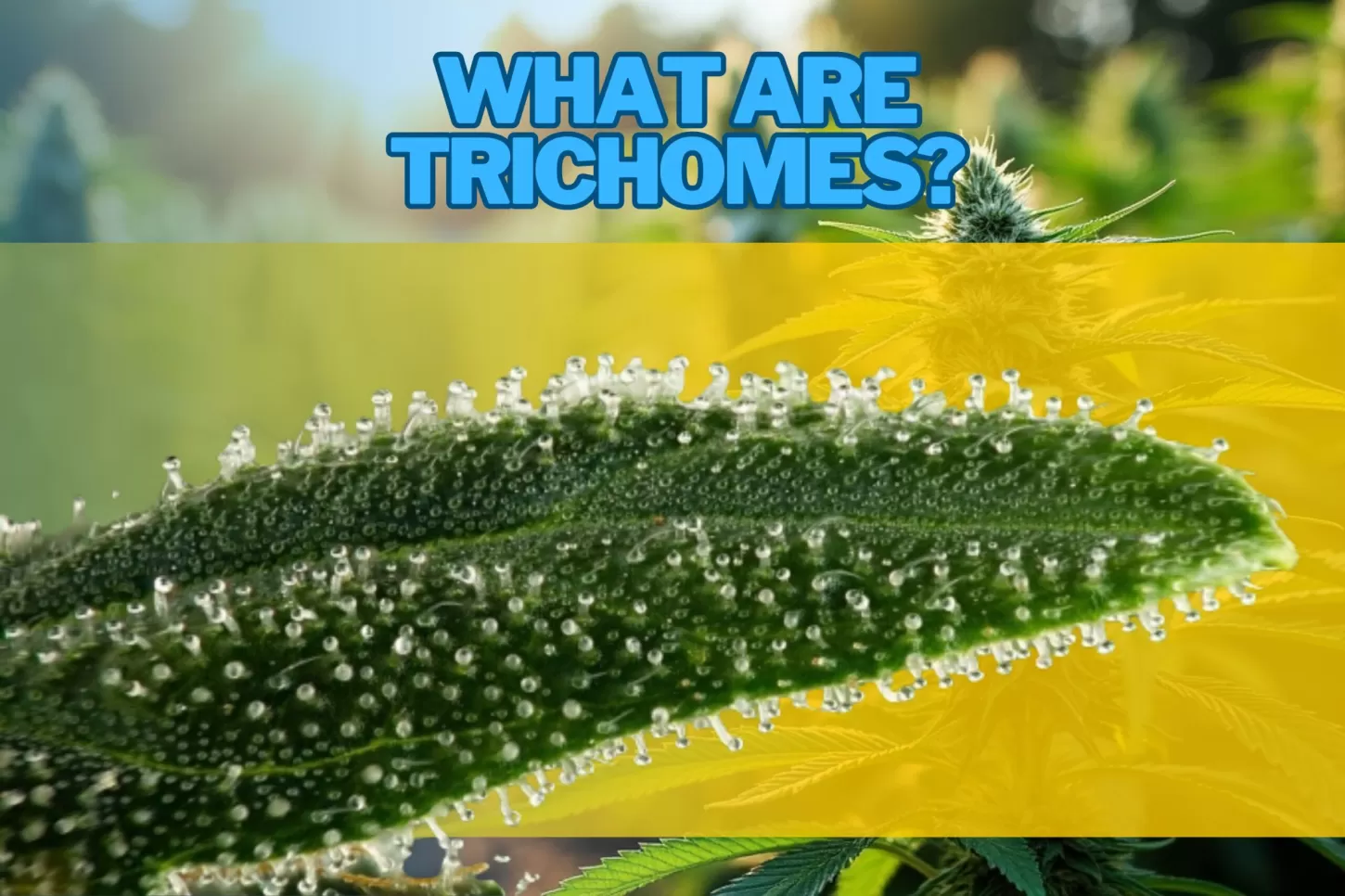
Trichomes are tiny, glandular outgrowths that are locations of chemical synthesis and defense. They are resinous structures that are densely covered on female cannabis flowers and adjacent sugar leaves so that the plant is protected against predators and environmental stresses such as insects, fungal diseases, and ultraviolet (UV) light. Their resinous secretion acts as a deterrent against herbivores and also prevents water loss by sealing the epidermal cells, creating a survival advantage for the plant under stressful conditions.
Biochemically, trichomes are where the biosynthesis of terpenes and cannabinoids occurs. It all starts with precursor molecules synthesized within the gland cells and continues through enzymatic processes that yield the unique chemical profiles that define each strain of cannabis. For the grower, trichomes are the tangible signals of potency, communicating critical information regarding the plant’s health and stage of ripeness. Their density and condition can directly influence the quality and market value of the harvested crop.
Cannabis can produce numerous varieties of trichomes, and each differs by morphology and biochemical activity according to their development stage and role in the plant’s life cycle.
1. Bulbous Trichomes
Bulbous trichomes are the shortest and most abundant on the entire plant but contribute little to the production of cannabinoids. Although they produce low resin yields, they form a protective micro-layer on the plant’s surface that may restrict water loss and shield from minor abrasions. Due to their microscopic size, they are virtually invisible to the human eye, but due to sheer numbers, they constitute an important component of the outer defense of the plant.
2. Capitate-Sessile Trichomes
The intermediate-sized trichomes have the glandular head directly attached to the epidermis. They enlarge during the early flowering stage, triggering excessive resin secretion. They fill the gap between the protective role of bulbous trichomes and the high cannabinoid production of mature glands. Cultivators note the appearance and density of capitate-sessile trichomes as signals that the crop is reaching a critical resin-forming stage.
3. Capitate-Stalked Trichomes
The strongest and most prominent capitate-stalked trichomes are the hallmark of quality cannabis blooms. Their enlarged stalk raises the resin gland above the plant’s surface, exposing it maximally to environmental stimulants, inducing resin production. These glands produce most of the THC, CBD, and aromatic terpenes, which directly control the psychoactive and medical action of the plant. Their density and color are the most important indicators of optimal harvest time.
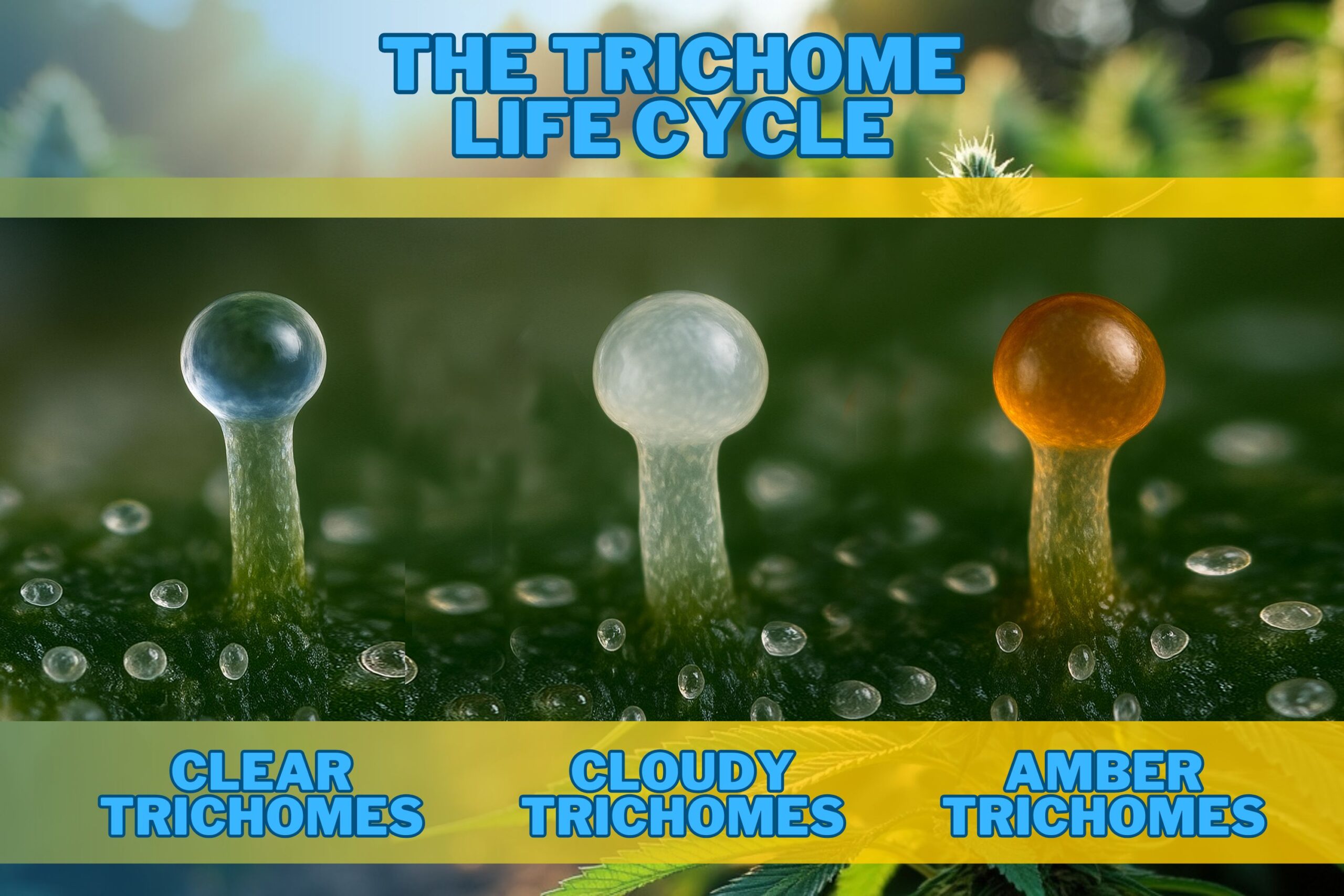
Cannabis trichomes undergo a predictable visual transformation that is a positive indicator of cannabinoid maturity and potency. Growers use these color transitions to identify the precise harvest time.
Clear Trichomes
In this initial phase, the glandular heads appear glassy and clear, indicating that cannabinoids are still in the process of development. When flowers are picked too early, they will have immature psychoactive characteristics and muted aromas. In this stage, the plant focuses on cell division and resin gland formation, laying the groundwork for cannabinoid deposits.
Cloudy or Milky Trichomes
As trichomes mature, the heads puff up and become clouded with resin containing cannabinoids, signaling the highest THC concentration. This is the best time to harvest for the highest potency as well as terpene profile. Also, the decrease in viscosity of the resin enhances the plant’s UV resistance as well as its susceptibility to infestation. Cultivators typically harvest when 70–90% of trichomes have become cloudy so that they obtain the optimal combination of psychoactivity and flavor.
Amber Trichomes
When trichomes turn amber, some of the THC oxidizes into cannabinol (CBN), and it is associated with sedation and a mellow body high. It is the phase preferred by medical users for relaxing effects or those who want to avoid intense cerebral activity from THC. Amber trichomes also indicate the imminent completion of the plant’s natural life cycle, during which cannabinoids begin to degrade and terpene profiles shift.
Trichomes are biosynthetic factories. In their glandular heads, enzymatic networks transform precursor molecules into complex phytochemicals.
Research has proven that trichomes have specialized plastids and glandular vesicles where enzyme-catalyzed processes take place. These processes also help the plant resist oxidative stress and control the product’s strength and taste. In addition, the entourage effect of the synergistic interaction between terpenes and cannabinoids is dependent on healthy and diverse trichome growth.
To cultivate cannabis rich in trichomes, growers must implement precise environmental and nutritional controls that promote resin gland production while minimizing stress that degrades quality.
Light Intensity and Spectrum
Correct light exposure is critical to triggering trichome development. It has been established through research that UVB light supplementation increases resin secretion as plants respond to UV stress by producing defense cannabinoids and terpenes. New LED full-spectrum light replicates the natural sunlight spectrum and allows for accurate adjustment, therefore providing growers with optimal trichome density while managing heat output.
Temperature and Humidity Control
Temperature extremes negatively influence the health of trichomes by inducing volatilization of aromatic oils or slowing down metabolic processes. Optimum temperatures of 20–26°C (68–78°F) during the flowering stage create conducive environments for the biosynthesis of cannabinoids. Relative humidity (RH) ranges of 40–50% reduce the incidence of mold and the integrity of resin. We must apply environmental controls such as humidifiers, dehumidifiers, and ventilation systems to regulate these parameters.
Nutrient Management
Balance in nutrition is what yields trichome quality and yield. Micronutrients like sulfur and magnesium are used as cofactors in terpene synthase enzymes to enable robust aromatic profiles. Organic compounds like kelp extracts and humic acids help facilitate plant nutrient uptake and root-plant beneficial microbe function enhancement, resulting in turn in trichome development. Pure water flush in the final weeks of flowering eliminates buildup, resulting in greater resin gland purity and clarity.
Trichomes are easily damaged and degraded by mechanical stress, heat, and light. Specific harvest and curing methods need to safeguard their whole chemical composition.
Harvest Techniques
Minimization of handling damage preserves the integrity of trichome structure in capitate-stalked trichomes. Sterilized, sharp tools, which give clean cuts without damaging trichomes, are utilized in harvesting. Harvesting during morning hours or in low-light conditions preserves the use of reduced trichome volatility due to the fact that resin glands are less prone to volatile oil evaporation.
Drying and Curing
Slow, controlled drying at 18–21°C (64–70°F) and 45–55% RH prevents rapid degradation of cannabinoids and terpenes. Slow drying ensures even moisture evaporation, without mold growth, and preserves resin quality. After drying, store the product in airtight containers and open them occasionally, allowing air to enter, which slowly converts chlorophyll and other unwanted stuff into something less harsh that tastes better.
Storage Conditions
Long-term weed trichome preservation requires storage in dark, cool environments. UV light exposure and fluctuating temperatures promote cannabinoid degradation. Dry cannabis should be stored in UV-proof glass containers at 15–18°C (59–65°F) to maintain terpene integrity and efficacy. Freezing is generally not advised since ice crystal formation can lead to rupture of the glandular heads with subsequent resin loss.
Visual inspection of trichomes entails the use of magnifying tools to determine minor differences in trichome color charts and clarity of glands.
To study trichomes, utilize proper lighting—natural light or daylight-balanced LEDs work best to prevent false color. Amber lenses or red-spectrum grow lights cannot be employed in studying because they will distort the color of existing trichome coloration and lead to making the wrong harvest time.

Curious about growing weed in a healthy, effective way? Welcome to the realm of weed hydro! This method uses water instead of soil, delivering n

Peyote Zkittlez is a unique cannabis strain that has quickly gained dedicated followers among enthusiasts and patients alike. Its parentage—Zk
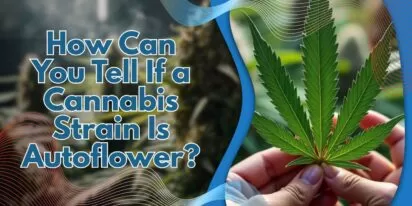
As growers, we want strains that work well, are strong, and are of good quality. Autoflowering cannabis strains are a big step forward for both

Pot growers always ask the same basic question: How much weed does a weed plant produce? The answer is complex and depends on a multitude of var

Ever had the room spin after a few hits? You're not alone. Figuring out how to prevent getting dizzy high can make your cannabis experience a wh
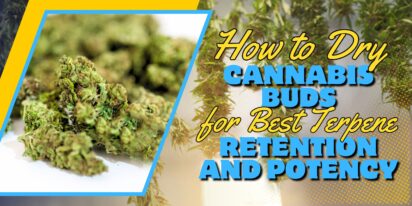
Drying cannabis properly is a critical process in preserving the plant's full aroma and flavor and its psychoactive abilities. Tampering with th

Ever caught yourself a bit too high and all of a sudden in need of being normal? Whether you're heading out for munchies or bumping into someone

Looking for sage advice on how not to get pinched with weed without batting an eye? Attempting to protect your stash from gossipy roommates, sno
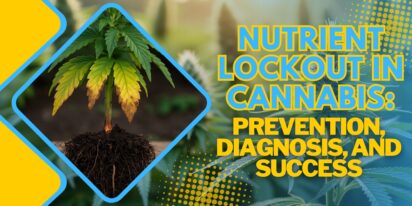
Nutrient lockout, also known as nutrient binding or chemical antagonism, is a significant issue in cannabis cultivation that negatively impacts
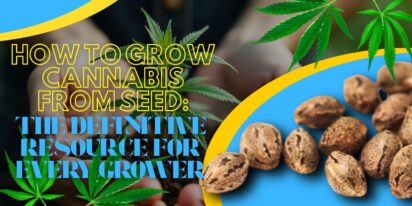
Germination is the most critical initial stage in growing healthy, high-quality cannabis plants. During germination, the dormant seed becomes a
Are You 21 Or Over?
YesOr
No By clicking yes, you certify that you are over 21 years old. By using this website, you agree to our legal disclaimer.
Excellent blog here Also your website loads up very fast What web host are you using Can I get your affiliate link to your host I wish my web site loaded up as quickly as yours lol
Your writing is not only informative but also incredibly inspiring. You have a knack for sparking curiosity and encouraging critical thinking. Thank you for being such a positive influence!
Simply wish to say your article is as amazing The clearness in your post is just nice and i could assume youre an expert on this subject Well with your permission let me to grab your feed to keep updated with forthcoming post Thanks a million and please carry on the gratifying work
Somebody essentially lend a hand to make significantly articles Id state That is the very first time I frequented your website page and up to now I surprised with the research you made to make this actual submit amazing Wonderful task
Your blog is a beacon of light in the often murky waters of online content. Your thoughtful analysis and insightful commentary never fail to leave a lasting impression. Keep up the amazing work!
Thank you for the auspicious writeup It in fact was a amusement account it Look advanced to more added agreeable from you By the way how could we communicate
Your blog is a constant source of inspiration for me. Your passion for your subject matter shines through in every post, and it’s clear that you genuinely care about making a positive impact on your readers.
Your blog is a constant source of inspiration for me. Your passion for your subject matter is palpable, and it’s clear that you pour your heart and soul into every post. Keep up the incredible work!
Your articles never fail to captivate me. Each one is a testament to your expertise and dedication to your craft. Thank you for sharing your wisdom with the world.
Your blog is a testament to your dedication to your craft. Your commitment to excellence is evident in every aspect of your writing. Thank you for being such a positive influence in the online community.
Your writing has a way of resonating with me on a deep level. I appreciate the honesty and authenticity you bring to every post. Thank you for sharing your journey with us.
Your blog is a true gem in the world of online content. I’m continually impressed by the depth of your research and the clarity of your writing. Thank you for sharing your wisdom with us.
Hi i think that i saw you visited my web site thus i came to Return the favore Im attempting to find things to enhance my siteI suppose its ok to use a few of your ideas
Somebody essentially help to make significantly articles Id state This is the first time I frequented your web page and up to now I surprised with the research you made to make this actual post incredible Fantastic job
Usually I do not read article on blogs however I would like to say that this writeup very compelled me to take a look at and do so Your writing taste has been amazed me Thanks quite nice post
Your blog has quickly become one of my favorites. Your writing is both insightful and thought-provoking, and I always come away from your posts feeling inspired. Keep up the phenomenal work!
Every time I visit your website, I’m greeted with thought-provoking content and impeccable writing. You truly have a gift for articulating complex ideas in a clear and engaging manner.
Hey there You have done a fantastic job I will certainly digg it and personally recommend to my friends Im confident theyll be benefited from this site
I have read some excellent stuff here Definitely value bookmarking for revisiting I wonder how much effort you put to make the sort of excellent informative website
Nice blog here Also your site loads up very fast What host are you using Can I get your affiliate link to your host I wish my site loaded up as quickly as yours lol
What i do not understood is in truth how you are not actually a lot more smartlyliked than you may be now You are very intelligent You realize therefore significantly in the case of this topic produced me individually imagine it from numerous numerous angles Its like men and women dont seem to be fascinated until it is one thing to do with Woman gaga Your own stuffs nice All the time care for it up
Your blog is a beacon of light in the often murky waters of online content. Your thoughtful analysis and insightful commentary never fail to leave a lasting impression. Keep up the amazing work!
Your blog is a breath of fresh air in the often stagnant world of online content. Your thoughtful analysis and insightful commentary never fail to leave a lasting impression. Thank you for sharing your wisdom with us.
Your blog is a beacon of light in the often murky waters of online content. Your thoughtful analysis and insightful commentary never fail to leave a lasting impression. Keep up the amazing work!
Usually I do not read article on blogs however I would like to say that this writeup very compelled me to take a look at and do it Your writing style has been amazed me Thank you very nice article
Your writing has a way of resonating with me on a deep level. I appreciate the honesty and authenticity you bring to every post. Thank you for sharing your journey with us.
This hydroponics guide is quite the buzz, seriously! Who knew growing weed without dirt could be so complicated yet potentially rewarding? The breakdown of systems like DWC and NFT is helpful, though I suspect my cat might confuse the air pump for a toy. The idea of cleaner buds is tempting, especially since explaining hydro weed to my non-growing friends might get messy. And the bit about potential dizziness from hydro weed? Perfect, now I have an excuse for why I always stumble a bit after a grow session. Still, the promise of faster grows and higher yields is hard to ignore, even if it means more trips to the pH meter than to the coffee shop. Overall, a cultivating read for the curious grower!